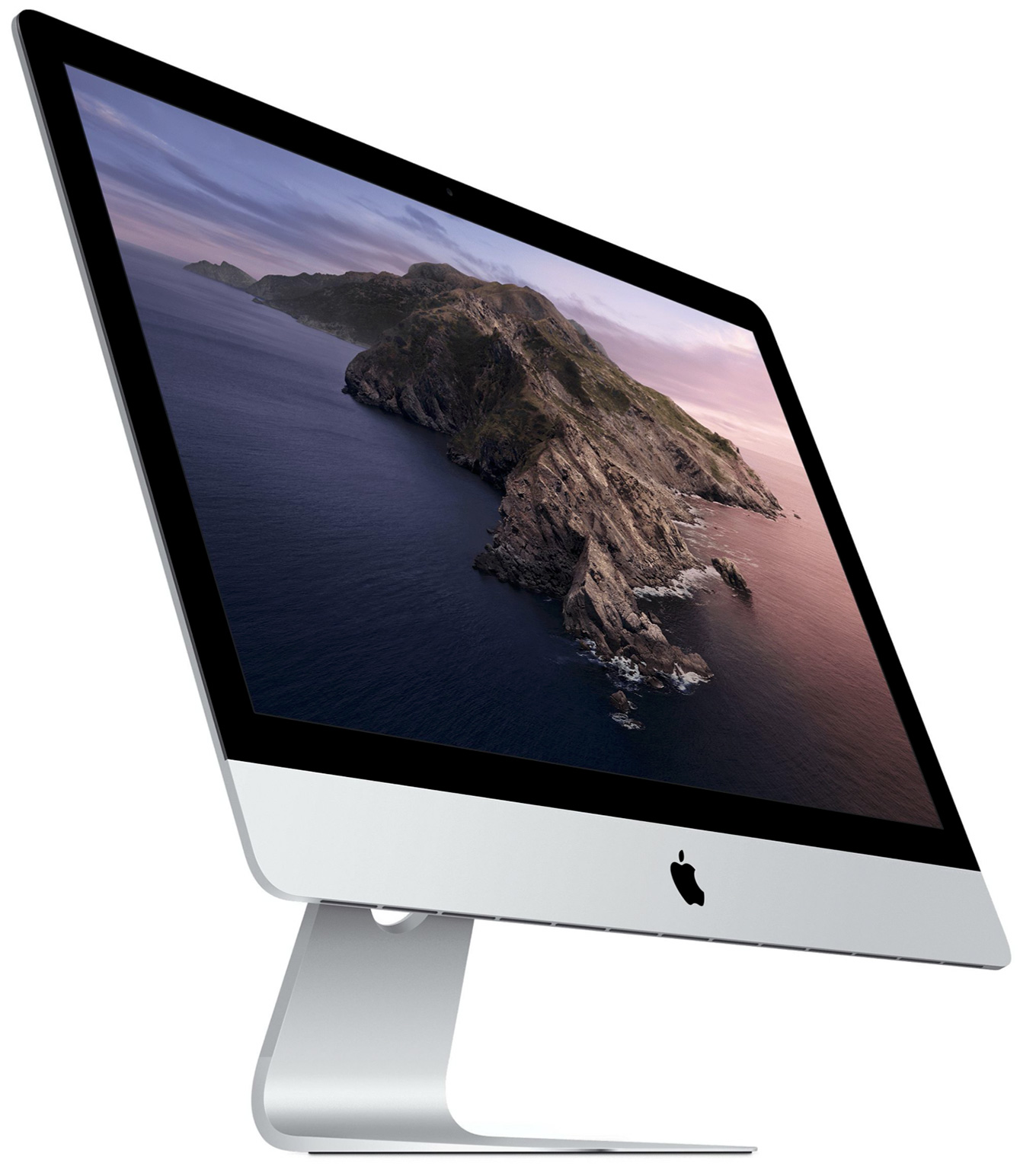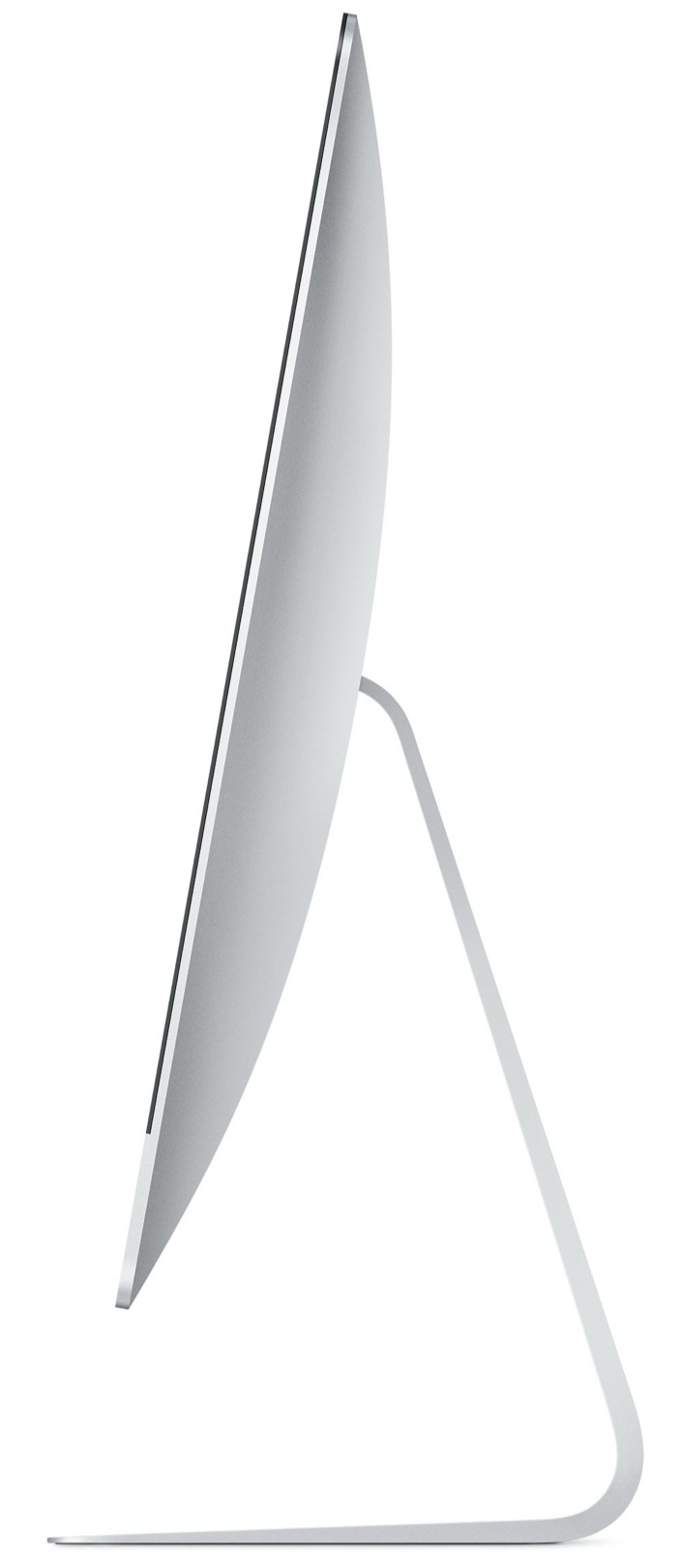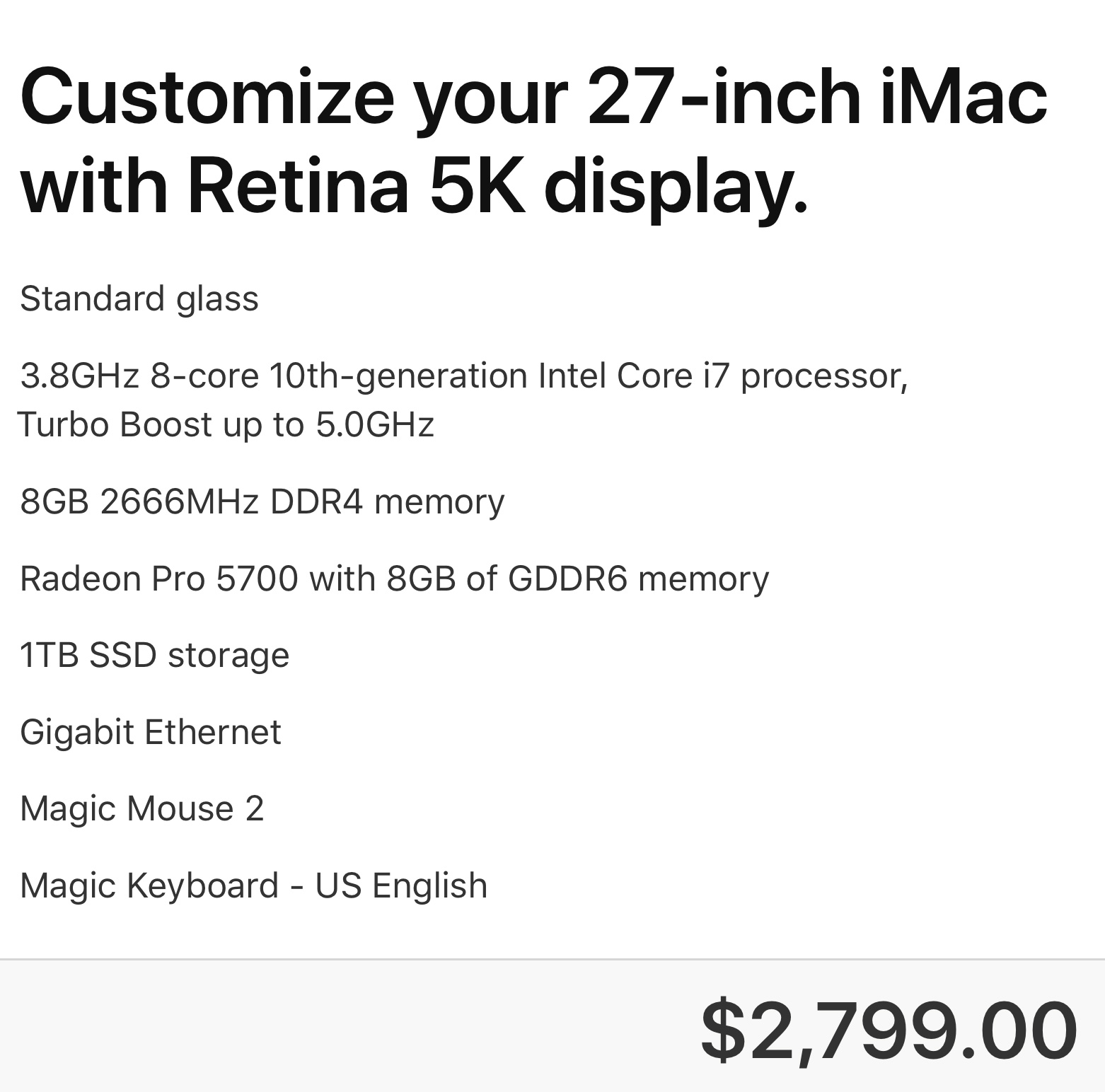 Last week, Apple updated both the 27″ iMac and the iMac Pro; though the iMac Pro got only a minor processor update. The question is, with the coming transition to Apple silicon, what should we do with these new systems?
Last week, Apple updated both the 27″ iMac and the iMac Pro; though the iMac Pro got only a minor processor update. The question is, with the coming transition to Apple silicon, what should we do with these new systems?
Initially, there was a big kerfuffle about these new Macs using the existing hardware design, as if the size of a computer’s bezels somehow affects its ability to process data. Design is valuable, but I don’t buy a Mac because of how it looks, I buy it for what it can do. Looks are good, performance is gooder.
I am not losing any sleep over the fact that the bezels on both my 2017 iMac and the new 2020 iMac are an inch wide. And the “chin” (lower silver part) of the system? That’s the best possible place to park all my yellow sticky notes.
NOTE: Apple updated the 27″ iMac, but not the 21″. The smaller system is very capable, but for video editing the larger screen, combined with the ability to upgrade RAM after the fact, make the 27″ iMac a better choice.

(All iMac images courtesy of Apple, Inc.)
So the first question we need to ask is: If I buy this iMac now, will it be obsolete in the future? Of course you know the answer: Absolutely yes. That’s been true of every computer made by every manufacturer for the last fifty years. The trend of continual hardware obsolescence will last long into the future.
A better question, though, is to ask: If I buy this Mac today, will I be able to use it for several years before it needs replacement? Here, again, the answer is: Yes. Every day I get emails from editors who are running their business on 2010, 2009, even 2008 Mac Pros and getting work done.
Macs are well-designed, well-built and any Mac you buy today will run for years. Period. You may not be able to fully upgrade it after a while, just as most 2010 Mac Pros are unable to run the latest version of the MacOS. However, you don’t need to run the latest OS to get productive work done. Even the oldest system is still fully capable of editing media on a daily basis.
You don’t need the latest gear to edit SD or HD video.
However, as we move into the world of HDR, 8K and 12K media and displays the size of moving vans, not to mention streaming multicam edits for these COVID times, you’ll need computers with more heft. 8K video pushes a lot of pixels. 12K media requires a mind-bending 75 MILLION pixels per frame!
NOTE: According to recent articles, the human eye is roughly equivalent to a frame size of 100 million pixels. So, we probably aren’t at the end of the “frame size race.”
So, why buy the latest 27″ iMac? According to an analysis published by AppleInsider.com, the iMac released by Apple last week has essentially the same power as the current Mac Pro, for about half the price.
In this new system, Apple boosted the CPU, GPU, RAM and storage. These systems are designed for power users who create stuff – from video to audio to code. If all you need is word processing, spreadsheets or browsing the web, these systems are overkill.
WHAT SHOULD YOU BUY?
To start, here’s Apple’s description of the latest systems.

Buying a new computer is always a balancing act between what you’d like and the money you have. Assuming you don’t have an unlimited budget, here’s how I suggest you spend it:
Processor. These iMacs offer i5, i7 and i9 processors. There is a BIG difference between an i5 and i9. I prefer an i7, simply for the price compared to an i9. Video editing does not require an i9. However, after using an i7 for years, then moving to an i5, I was surprised at the drop in interface responsiveness.
After a while, I stopped noticing. But, initially, the difference was dramatic. My next system will not have an i5 in it.
RAM. Apple RAM is desperately overpriced. There is no need to spend your dollars with Apple where, for half the price, or less, you can get far more RAM from OWC or Kingston or Crucial. It is easy to upgrade RAM in the 27″ iMac, unlike almost all other Apple devices. If this process makes you nervous, ask a friendly high school student to do it for you.
However, in your planning, I would aim for 32 GB of RAM. 16 GB is the minimum and there’s no advantage to getting more than 64 GB – except for bragging rights. Your editing will never need it.
GPU. The sweet spot for most GPUs is the middle choice. In this case, the Radeon Pro 5700 with 8 GB of VRAM. If you are doing effects heavy work, that you KNOW uses the GPU, spend the extra $200 for more VRAM. However, for most of us, save your money for more storage.
NOTE: Not all apps use the GPU for graphics work. If the apps you rely on use the CPU, then an i9 processor will be a better choice. I’d still go for the mid-range GPU, though, because Apple is really encouraging developers to leverage the GPU as much as possible when they upgrade their applications.
Storage. Regardless of how much storage you buy, it is never enough. You will ALWAYS need to purchase external storage. My current iMac has 2 TB of storage; however, I’m only using 400 GB of it. Why? Because I have 150 TB of external storage. I recommend 1 TB for internal storage. This provides plenty of space for your apps, plus lots of room for work files. The difference in price between 512GB and 1 TB is minor, while the performance is worth it. You can spend more, but, again, you’ll still need external storage. Save your dollars for a fast RAID or NVMe SSDs.
Ethernet. Unless you are hard-wired to a fast server, there’s no need for 10 Gb Ethernet. WiFi doesn’t provide that level of speed. However, if you, like me, are planning to upgrade your network to 10 Gb Ethernet, then this option makes sense. 10 Gb Ethernet will not make any difference in the speed with which you access the web.
Nano-Texture glass. Um, which is easier – spending $500 or turning your Mac so it doesn’t face any windows?
Mice. I am not a fan of Magic Mice. I prefer third-party mice with an Apple keyboard. And I’ve never seen the benefit of trackpads for video editing. But that’s just me.
PRICING

I started with the 27″ iMac with the i7 processor. (It’s the iMac on the far right of Apple’s iMac page.)
I kept the RAM at 8 GB so I can add 32 GB of third-party RAM (using 2 sticks) later. This would bring my total RAM to 40 GB, because the iMac holds up to 4 sticks of RAM.
NOTE: 32GB of additional RAM from OWC costs $119.76 vs. $600 from Apple.
I would add the mid-range GPU, along with 1 TB storage.
My final system is $2,799, plus $120 for OWC for a rough total of $2,920 (US).
WHAT ABOUT APPLE SILICON?
 (An illustration of an Apple silicon processor. Courtesy of Henriok / CC0.)
(An illustration of an Apple silicon processor. Courtesy of Henriok / CC0.)
I am very excited about the potential for Apple silicon. I think it will change our industry. But, it isn’t shipping yet. In fact, new iMac systems using Apple silicon have not yet started generating rumors. This means that high-end iMacs are not likely to be shipping for many, MANY months yet.
If you don’t need a Mac “right now,” think about this: Apple would not make the transition to Apple silicon in order to create systems with lower prices. That has never been their strategy. In every CPU transition – from 68K to PowerPC to Intel – performance has ALWAYS improved, while prices held steady.
NOTE: The original 128K Mac, released back in 1984, was priced at $2,499. And, yes, I bought one.
My expectation is that with these new systems prices will remain roughly the same, but performance will be SIGNIFICANTLY faster. But, Apple silicon is unknown technology. Apple’s keynote not withstanding, until Apple actually ships a computer we can use for every day work, as opposed to systems for developers to test products, we won’t actually know what the results of the move to Apple silicon will be.
So, if you are looking to make a safe choice, or you need a computer right now, the new 27″ iMac is an excellent choice. It runs all current Mac and, if needed, Windows software. It is proven technology in an established form-factor. You can be up and running 30 minutes after you open the box.
Plus, it has performance to burn.
128 Responses to Configure a 2020 27″ iMac for Video Editing – Should You Buy?
Newer Comments →-
 Constance says:
Constance says:
August 17, 2020 at 7:01 am
-
 Larry says:
Larry says:
August 17, 2020 at 8:37 am
-
 Vinson Valega says:
Vinson Valega says:
August 17, 2020 at 9:10 am
-
 Bill Donavan says:
Bill Donavan says:
August 17, 2020 at 11:49 am
-
 Joe says:
Joe says:
August 17, 2020 at 12:30 pm
-
 Larry says:
Larry says:
August 17, 2020 at 12:42 pm
-
 Michael Vlietstra says:
Michael Vlietstra says:
August 17, 2020 at 6:34 pm
-
 Larry says:
Larry says:
August 17, 2020 at 8:15 pm
-
 Ronald Matchett says:
Ronald Matchett says:
August 18, 2020 at 5:40 am
-
 Larry says:
Larry says:
August 18, 2020 at 11:22 am
-
 Larry says:
Larry says:
August 18, 2020 at 7:28 pm
-
 Ron Matchett says:
Ron Matchett says:
August 24, 2020 at 2:12 pm
-
 Lori Petersen Waite says:
Lori Petersen Waite says:
August 18, 2020 at 6:25 am
-
 Larry says:
Larry says:
August 18, 2020 at 11:21 am
-
 Marty Vermillion says:
Marty Vermillion says:
August 19, 2020 at 1:40 pm
-
 Larry says:
Larry says:
August 19, 2020 at 1:50 pm
-
 Steve Schwartz says:
Steve Schwartz says:
August 19, 2020 at 3:13 pm
-
 Larry says:
Larry says:
August 19, 2020 at 3:37 pm
-
 Larry Tempesta says:
Larry Tempesta says:
August 24, 2020 at 7:00 am
-
 Larry says:
Larry says:
August 24, 2020 at 8:00 am
-
 Ian Love says:
Ian Love says:
August 28, 2020 at 8:56 pm
-
 Larry says:
Larry says:
August 28, 2020 at 9:01 pm
Newer Comments →Larry, your advice on iMac purchases and configuration is so helpful.
Thank you,
Constance
Constance:
Thanks for the kind words. It is hard, when you get right down to it, to figure out where to spend money. My goal is to give your thinking a place to start.
Larry
Larry Rocks!! TY, LJ!!
..well reasoned, thanks.
It is so hard to really understand your NEEDS in this industry. Thank you Larry spot on as usual.
Joe:
I agree. This might help:
* The more clips you plan to use, the more storage becomes important.
* The more effects you plan to use, the more the GPU becomes important, however different GPUs do NOT provide different quality, just faster performance in calculating the effect.
* Larger frame sizes, more multicam angles or HDR media requires more from the CPU.
When configuring gear, WHAT we plan to do is unimportant. Thinking about the media we plan to use is critical.
Larry
Hi Larry,
Thanks for another informative article, really appreciate all of your time and dedication to making our struggles easier.
For editing/playback in Premiere of 4K video in the Sony MXF format, would you recommend a 2020 iMac with the i9 10-core or an iMac Pro with the Xeon W 14-core processor? I also do limited After Effects work, along with using Photoshop/Illustrator/Lightroom for many projects.
I know the iMac Pro is an older machine but has the benefits of an upgraded cooling system and two separate Thunderbolt busses.
Thanks Larry!
Mike.
Michael:
Based on your description, you don’t “need” the i9, the i7 would be fine. And both the 27″ iMac and iMac Pro could easily handle this. I’d vote for the new 27″ iMac.
Larry
P.S. That’s not to say the i9 would not be a good idea, simply that it is not required for the media you are editing.
Hello Larry,
Will the new 2020 iMacs be able to have Mojave installed? I’m still not using Catalina yet.
Thanks!
Ron
Ron:
My guess is not, but I’m checking.
Larry
Ron:
I just confirmed with Apple that the 2020 27” iMac will only run Catalina or later. Not Mojave.
Larry
Thanks, Larry!
Hi Larry – your write-up was excellent. (Love the advise you give for extra RAM.) Do you use a second monitor with the 27″ iMac? I’d jump in with both feet on getting one if it weren’t for the one 27″ monitor – the screen real estate is too small to be really efficient with editing, I find. Your thoughts?
Lori:
Thanks for your kind words. I’m a big fan – and daily user of – the LG 27″ UHD 4K display.
https://larryjordan.com/articles/product-review-lg-27-uhd-4k-display-27ul600-w/
Larry
Hi Larry,
I was putting together plans for a new 27″ iMac and made adjustments based on your suggestions. Two questions, Why is the Microsoft Office and Microsoft Office 365 not available with this Mac?. Also, do you have a tutorial on how to install the after market RAM?
Thanks and stay safe!
Marty
Marty:
Hmm… I’m not sure why Microsoft Office isn’t available. That’s a question you’ll need to ask Microsoft.
I don’t have a tutorial on installing RAM because there are MANY out there – just do a Google search. It is very easy and doesn’t require taking the cover off the computer.
Larry
Hi Larry,
I have a project capturing SD and Hi-8 tapes to digital for editing/archiving. Will I have issues with the new iMac because the 32 bit video or Catalina and T-2/ chip.
Have you any suggestions for a work flow working with old SD tapes.
My Mac Pro 1,1 stoped working about 3 months ago.
Steve:
Capture your SD material to ProRes 422 and you’ll be fine. The new iMac won’t work with 32-bit codecs, however ProRes is 64-bit.
ProRes supports SD, HD and 4K with no problem. Be sure to deirterlace.
If you can, use a Time-base corrector, your images will look much better:
https://larryjordan.com/articles/capturing-old-footage/
Premiere does a better job working with tape than FCP X.
Larry
if I want to future proof as much as I can, should I go the iMac Pro route or the new 2020 iMac maxed out? Im a broadcast video editor, mostly promos but some long form reality as well. 4k, 8k, etc. Im comimg from a 2014 5k iMac and finally decided to purchase the imac pro 10core, radeon pro vega 64x and then they dropped the new iMac. Do you thini they are going to update the imac pro or is this new imac essentially the imac pro killer?
thanks
Larry:
Based on recently published reports, the 2020 27″ iMac is essentially equal to the current iMac Pro, for about 1/2 the price. I don’t know what Apple will do in the future, but, if you need to spend money right now, I’d recommend the iMac.
As for “future proofing,” I think this is a fools errand. Keep in mind that Apple has already announced a transition from Intel to Apple silicon. These systems will start hitting the market in a year or so. Rather than focus on the future, think about what you need to get done right now and make sure the machine you get can handle it.
Larry
Thank you so much, Larry! I recently got hired for regular Final Cut work and desperately needed a hardware upgrade. I basically followed your advice (but went with the 16GB of Pro Radeon instead), and will buy some RAM from OWC. I’m excited to start!
Ian:
Congratulations on your new gig! May it last for years.
You made a good choice – enjoy your new system.
Larry